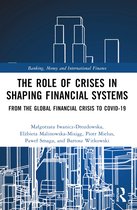Financial Crises and What to Do About Them And What to Do About Them
Afbeeldingen
Sla de afbeeldingen over
Artikel vergelijken
Uitgever: Oxford University Press
- Engels
- Paperback
- 9780199257447
- 08 augustus 2002
- 206 pagina's
Samenvatting
This work explains the patterns behind financial crises, examines international financial architecture, makes recommendations for avoiding the dangers of crises (and managing them better when they do occur), and shows how official efforts to strengthen the international financial system may have made life more difficult for the poorest countries.
In this accessible book, a leading expert provides a critical assessment of the official sector's efforts to more effectively manage financial crises in emerging markets. Professor Eichengreen reviews international initiatives on both the crisis prevention and crisis resolution fronts. While crises will always be with us, he concludes that good progress has been made in limiting their spread and strengthening the international financial system. Ironically, however, official-sector initiatives in this area may in fact have made life more difficult for the poorest countries. Initiatives to limit the incidence of crises and threats to the stability of the international financial system should therefore be linked to an increase in development assistance designed to offset the extra burdens on the poorest countries. The other place where official efforts have fallen short is in creating new ways of resolving crises. The author argues that the old way-official sector financing through the International Monetary Fund-is part of the problem, not part of the solution. The Fund's financial operations allow investors to escape without significant losses, which in turn encourages them to lend without regard to the risks, weakening market discipline. Moreover, bailouts are inequitable. Because investors are allowed to exit and the IMF ultimately gets paid back, the residents of the crisis country end up footing the bill. This is one reason why IMF programs have come to be regarded with such animus in the developing world. Imagining that the solution is for the official community to simply show the resolve to resist bailouts is too easy. That the International Monetary Fund has repeatedly come under pressure to extend financial assistance reflects more than a lack of political will; it reflects the inadequacy of the alternatives. At the same time, seeking to create radical new alternatives like an international bankruptcy court is too hard. It would do more to increase the efficiency of resource allocation and the stability of financial markets, the author concludes, to concentrate on more modest changes, namely the introduction of restructuring-friendly provisions into loan agreements, enhancing the capacity of creditors and debtors to resolve debt problems on their own.
In this accessible book, a leading expert provides a critical assessment of the official sector's efforts to more effectively manage financial crises in emerging markets. Professor Eichengreen reviews international initiatives on both the crisis prevention and crisis resolution fronts. While crises will always be with us, he concludes that good progress has been made in limiting their spread and strengthening the international financial system. Ironically, however, official-sector initiatives in this area may in fact have made life more difficult for the poorest countries. Initiatives to limit the incidence of crises and threats to the stability of the international financial system should therefore be linked to an increase in development assistance designed to offset the extra burdens on the poorest countries. The other place where official efforts have fallen short is in creating new ways of resolving crises. The author argues that the old way-official sector financing through the International Monetary Fund-is part of the problem, not part of the solution. The Fund's financial operations allow investors to escape without significant losses, which in turn encourages them to lend without regard to the risks, weakening market discipline. Moreover, bailouts are inequitable. Because investors are allowed to exit and the IMF ultimately gets paid back, the residents of the crisis country end up footing the bill. This is one reason why IMF programs have come to be regarded with such animus in the developing world. Imagining that the solution is for the official community to simply show the resolve to resist bailouts is too easy. That the International Monetary Fund has repeatedly come under pressure to extend financial assistance reflects more than a lack of political will; it reflects the inadequacy of the alternatives. At the same time, seeking to create radical new alternatives like an international bankruptcy court is too hard. It would do more to increase the efficiency of resource allocation and the stability of financial markets, the author concludes, to concentrate on more modest changes, namely the introduction of restructuring-friendly provisions into loan agreements, enhancing the capacity of creditors and debtors to resolve debt problems on their own.
Productspecificaties
Wij vonden geen specificaties voor jouw zoekopdracht '{SEARCH}'.
Inhoud
- Taal
- en
- Bindwijze
- Paperback
- Oorspronkelijke releasedatum
- 08 augustus 2002
- Aantal pagina's
- 206
- Illustraties
- Nee
Betrokkenen
- Hoofdauteur
- Barry Eichengreen
- Tweede Auteur
- Barry J. Eichengreen
- Hoofduitgeverij
- Oxford University Press
Vertaling
- Originele titel
- Financial Crises and What to Do about Them
Overige kenmerken
- Editie
- New title
- Extra groot lettertype
- Nee
- Product breedte
- 138 mm
- Product hoogte
- 12 mm
- Product lengte
- 215 mm
- Studieboek
- Ja
- Verpakking breedte
- 138 mm
- Verpakking hoogte
- 12 mm
- Verpakking lengte
- 215 mm
- Verpakkingsgewicht
- 248 g
EAN
- EAN
- 9780199257447
Je vindt dit artikel in
- Categorieën
- Beschikbaarheid
- Leverbaar
- Boek, ebook of luisterboek?
- Boek
- Taal
- Engels
- Studieboek of algemeen
- Algemene boeken
Kies gewenste uitvoering
Kies je bindwijze
(2)
Prijsinformatie en bestellen
De prijs van dit product is 49 euro en 99 cent.
2 - 3 weken
Verkoop door bol
- Prijs inclusief verzendkosten, verstuurd door bol
- Ophalen bij een bol afhaalpunt mogelijk
- 30 dagen bedenktijd en gratis retourneren
- Dag en nacht klantenservice
Shop dit artikel
Rapporteer dit artikel
Je wilt melding doen van illegale inhoud over dit artikel:
- Ik wil melding doen als klant
- Ik wil melding doen als autoriteit of trusted flagger
- Ik wil melding doen als partner
- Ik wil melding doen als merkhouder
Geen klant, autoriteit, trusted flagger, merkhouder of partner? Gebruik dan onderstaande link om melding te doen.










